Tesco's Business Strategy: Macro Analysis & Strategic Planning
VerifiedAdded on 2023/01/05
|17
|4467
|2
Report
AI Summary
This report provides a comprehensive analysis of Tesco's business strategy, examining the impact of the macro environment through PESTLE and SWOT analyses, and assessing internal capabilities using McKinsey's 7S model, the VRIO framework, benchmarking, and value chain analysis. It evaluates the competitive landscape using Porter's Five Forces model and proposes a strategic plan for Tesco, outlining strategies, objectives, and tactics for future growth and sustainability. The report leverages various business theories and concepts to interpret strategic directions available to Tesco, offering insights into cost leadership, competitive advantage, and market positioning. Desklib is a great resource for students needing more examples of solved assignments.
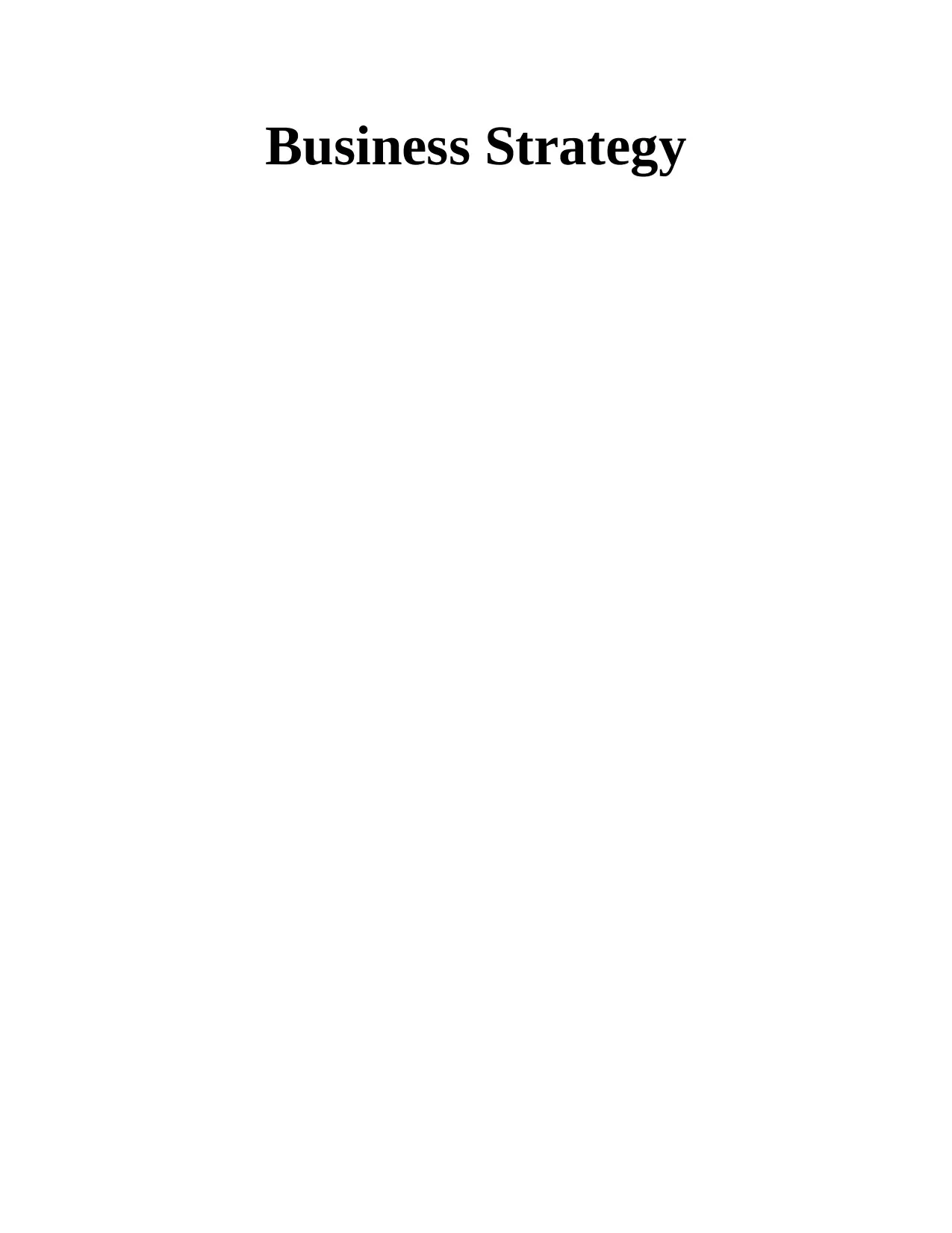
Business Strategy
Paraphrase This Document
Need a fresh take? Get an instant paraphrase of this document with our AI Paraphraser
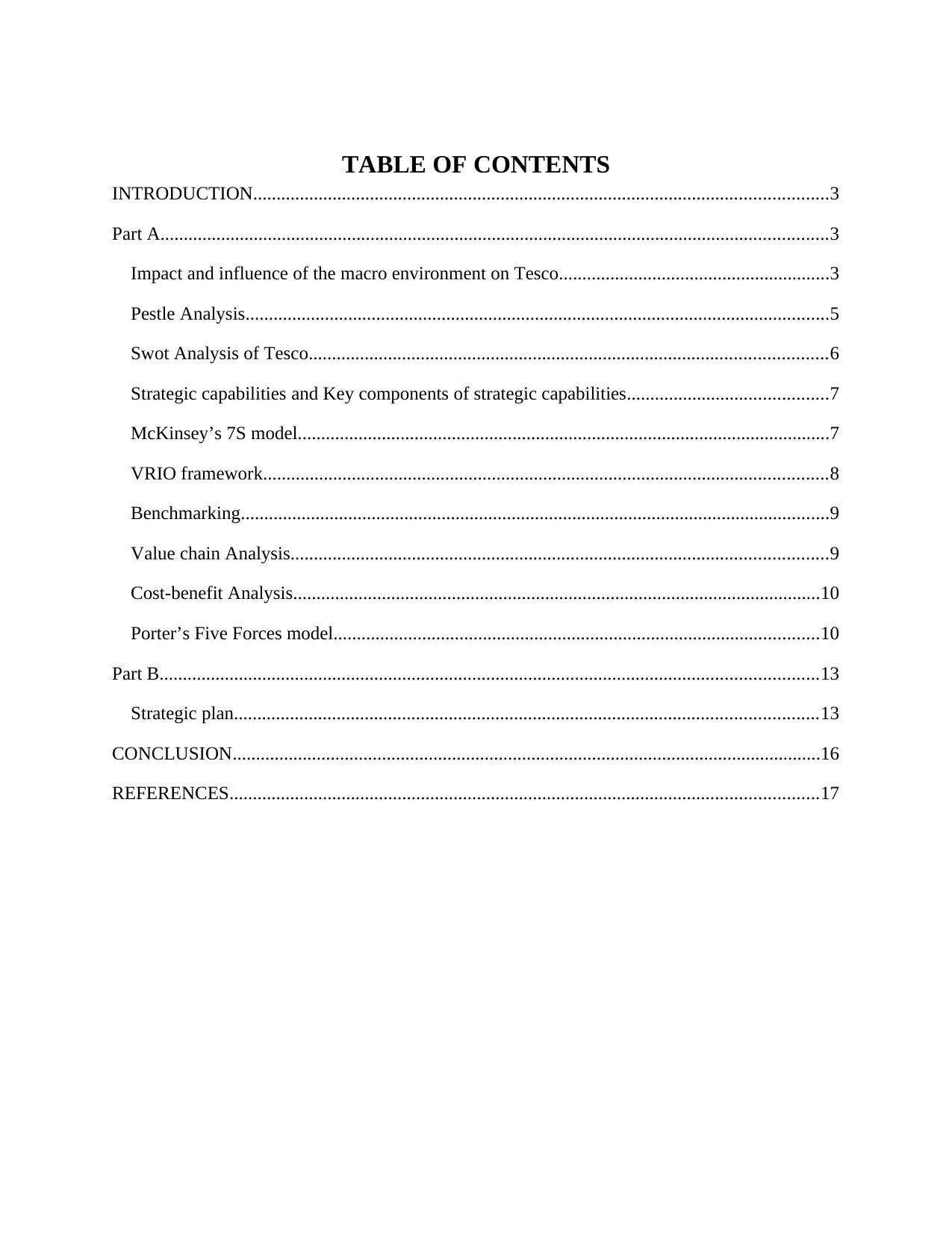
TABLE OF CONTENTS
INTRODUCTION...........................................................................................................................3
Part A...............................................................................................................................................3
Impact and influence of the macro environment on Tesco..........................................................3
Pestle Analysis.............................................................................................................................5
Swot Analysis of Tesco...............................................................................................................6
Strategic capabilities and Key components of strategic capabilities...........................................7
McKinsey’s 7S model..................................................................................................................7
VRIO framework.........................................................................................................................8
Benchmarking..............................................................................................................................9
Value chain Analysis...................................................................................................................9
Cost-benefit Analysis.................................................................................................................10
Porter’s Five Forces model........................................................................................................10
Part B.............................................................................................................................................13
Strategic plan.............................................................................................................................13
CONCLUSION..............................................................................................................................16
REFERENCES..............................................................................................................................17
INTRODUCTION...........................................................................................................................3
Part A...............................................................................................................................................3
Impact and influence of the macro environment on Tesco..........................................................3
Pestle Analysis.............................................................................................................................5
Swot Analysis of Tesco...............................................................................................................6
Strategic capabilities and Key components of strategic capabilities...........................................7
McKinsey’s 7S model..................................................................................................................7
VRIO framework.........................................................................................................................8
Benchmarking..............................................................................................................................9
Value chain Analysis...................................................................................................................9
Cost-benefit Analysis.................................................................................................................10
Porter’s Five Forces model........................................................................................................10
Part B.............................................................................................................................................13
Strategic plan.............................................................................................................................13
CONCLUSION..............................................................................................................................16
REFERENCES..............................................................................................................................17
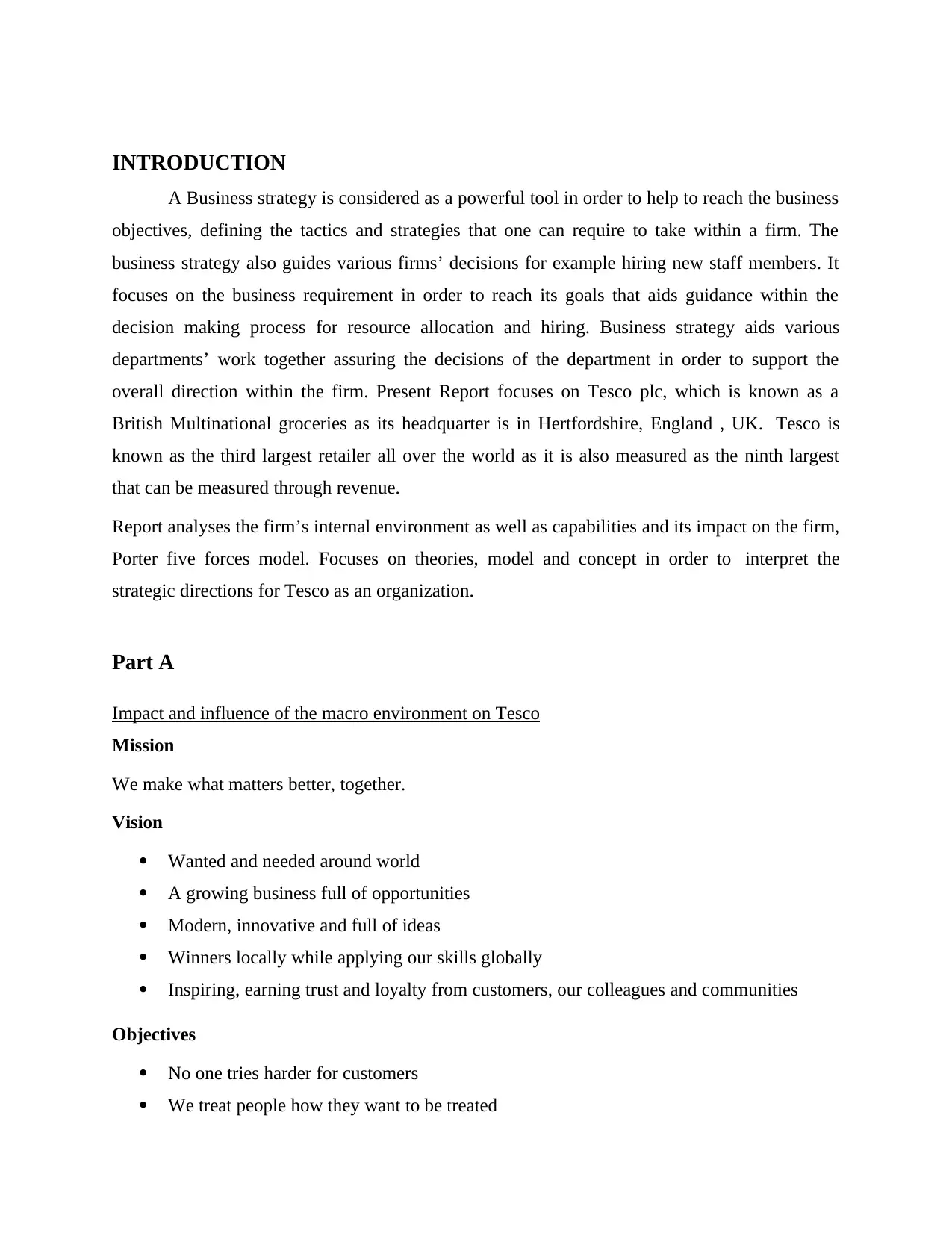
INTRODUCTION
A Business strategy is considered as a powerful tool in order to help to reach the business
objectives, defining the tactics and strategies that one can require to take within a firm. The
business strategy also guides various firms’ decisions for example hiring new staff members. It
focuses on the business requirement in order to reach its goals that aids guidance within the
decision making process for resource allocation and hiring. Business strategy aids various
departments’ work together assuring the decisions of the department in order to support the
overall direction within the firm. Present Report focuses on Tesco plc, which is known as a
British Multinational groceries as its headquarter is in Hertfordshire, England , UK. Tesco is
known as the third largest retailer all over the world as it is also measured as the ninth largest
that can be measured through revenue.
Report analyses the firm’s internal environment as well as capabilities and its impact on the firm,
Porter five forces model. Focuses on theories, model and concept in order to interpret the
strategic directions for Tesco as an organization.
Part A
Impact and influence of the macro environment on Tesco
Mission
We make what matters better, together.
Vision
Wanted and needed around world
A growing business full of opportunities
Modern, innovative and full of ideas
Winners locally while applying our skills globally
Inspiring, earning trust and loyalty from customers, our colleagues and communities
Objectives
No one tries harder for customers
We treat people how they want to be treated
A Business strategy is considered as a powerful tool in order to help to reach the business
objectives, defining the tactics and strategies that one can require to take within a firm. The
business strategy also guides various firms’ decisions for example hiring new staff members. It
focuses on the business requirement in order to reach its goals that aids guidance within the
decision making process for resource allocation and hiring. Business strategy aids various
departments’ work together assuring the decisions of the department in order to support the
overall direction within the firm. Present Report focuses on Tesco plc, which is known as a
British Multinational groceries as its headquarter is in Hertfordshire, England , UK. Tesco is
known as the third largest retailer all over the world as it is also measured as the ninth largest
that can be measured through revenue.
Report analyses the firm’s internal environment as well as capabilities and its impact on the firm,
Porter five forces model. Focuses on theories, model and concept in order to interpret the
strategic directions for Tesco as an organization.
Part A
Impact and influence of the macro environment on Tesco
Mission
We make what matters better, together.
Vision
Wanted and needed around world
A growing business full of opportunities
Modern, innovative and full of ideas
Winners locally while applying our skills globally
Inspiring, earning trust and loyalty from customers, our colleagues and communities
Objectives
No one tries harder for customers
We treat people how they want to be treated
⊘ This is a preview!⊘
Do you want full access?
Subscribe today to unlock all pages.

Trusted by 1+ million students worldwide
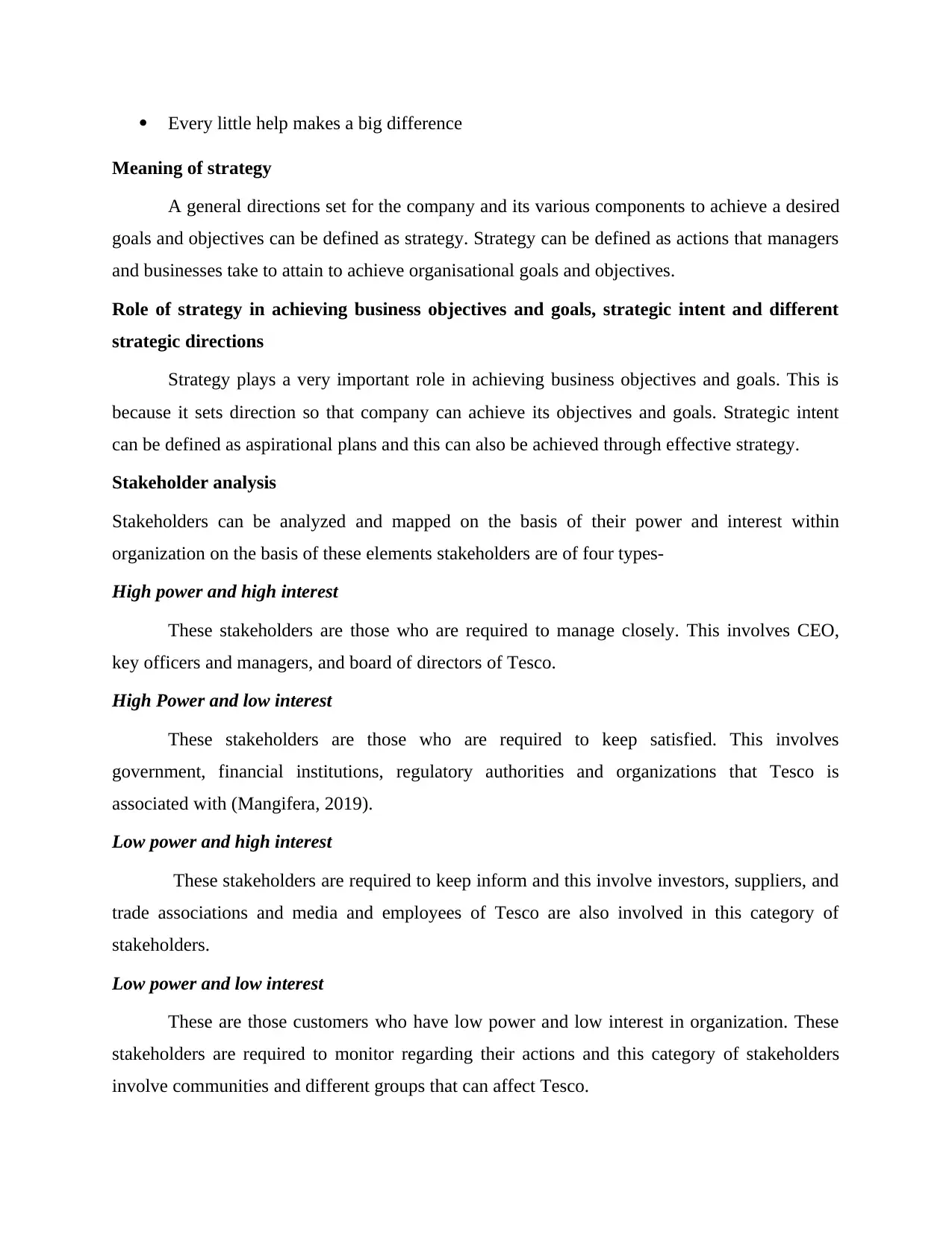
Every little help makes a big difference
Meaning of strategy
A general directions set for the company and its various components to achieve a desired
goals and objectives can be defined as strategy. Strategy can be defined as actions that managers
and businesses take to attain to achieve organisational goals and objectives.
Role of strategy in achieving business objectives and goals, strategic intent and different
strategic directions
Strategy plays a very important role in achieving business objectives and goals. This is
because it sets direction so that company can achieve its objectives and goals. Strategic intent
can be defined as aspirational plans and this can also be achieved through effective strategy.
Stakeholder analysis
Stakeholders can be analyzed and mapped on the basis of their power and interest within
organization on the basis of these elements stakeholders are of four types-
High power and high interest
These stakeholders are those who are required to manage closely. This involves CEO,
key officers and managers, and board of directors of Tesco.
High Power and low interest
These stakeholders are those who are required to keep satisfied. This involves
government, financial institutions, regulatory authorities and organizations that Tesco is
associated with (Mangifera, 2019).
Low power and high interest
These stakeholders are required to keep inform and this involve investors, suppliers, and
trade associations and media and employees of Tesco are also involved in this category of
stakeholders.
Low power and low interest
These are those customers who have low power and low interest in organization. These
stakeholders are required to monitor regarding their actions and this category of stakeholders
involve communities and different groups that can affect Tesco.
Meaning of strategy
A general directions set for the company and its various components to achieve a desired
goals and objectives can be defined as strategy. Strategy can be defined as actions that managers
and businesses take to attain to achieve organisational goals and objectives.
Role of strategy in achieving business objectives and goals, strategic intent and different
strategic directions
Strategy plays a very important role in achieving business objectives and goals. This is
because it sets direction so that company can achieve its objectives and goals. Strategic intent
can be defined as aspirational plans and this can also be achieved through effective strategy.
Stakeholder analysis
Stakeholders can be analyzed and mapped on the basis of their power and interest within
organization on the basis of these elements stakeholders are of four types-
High power and high interest
These stakeholders are those who are required to manage closely. This involves CEO,
key officers and managers, and board of directors of Tesco.
High Power and low interest
These stakeholders are those who are required to keep satisfied. This involves
government, financial institutions, regulatory authorities and organizations that Tesco is
associated with (Mangifera, 2019).
Low power and high interest
These stakeholders are required to keep inform and this involve investors, suppliers, and
trade associations and media and employees of Tesco are also involved in this category of
stakeholders.
Low power and low interest
These are those customers who have low power and low interest in organization. These
stakeholders are required to monitor regarding their actions and this category of stakeholders
involve communities and different groups that can affect Tesco.
Paraphrase This Document
Need a fresh take? Get an instant paraphrase of this document with our AI Paraphraser
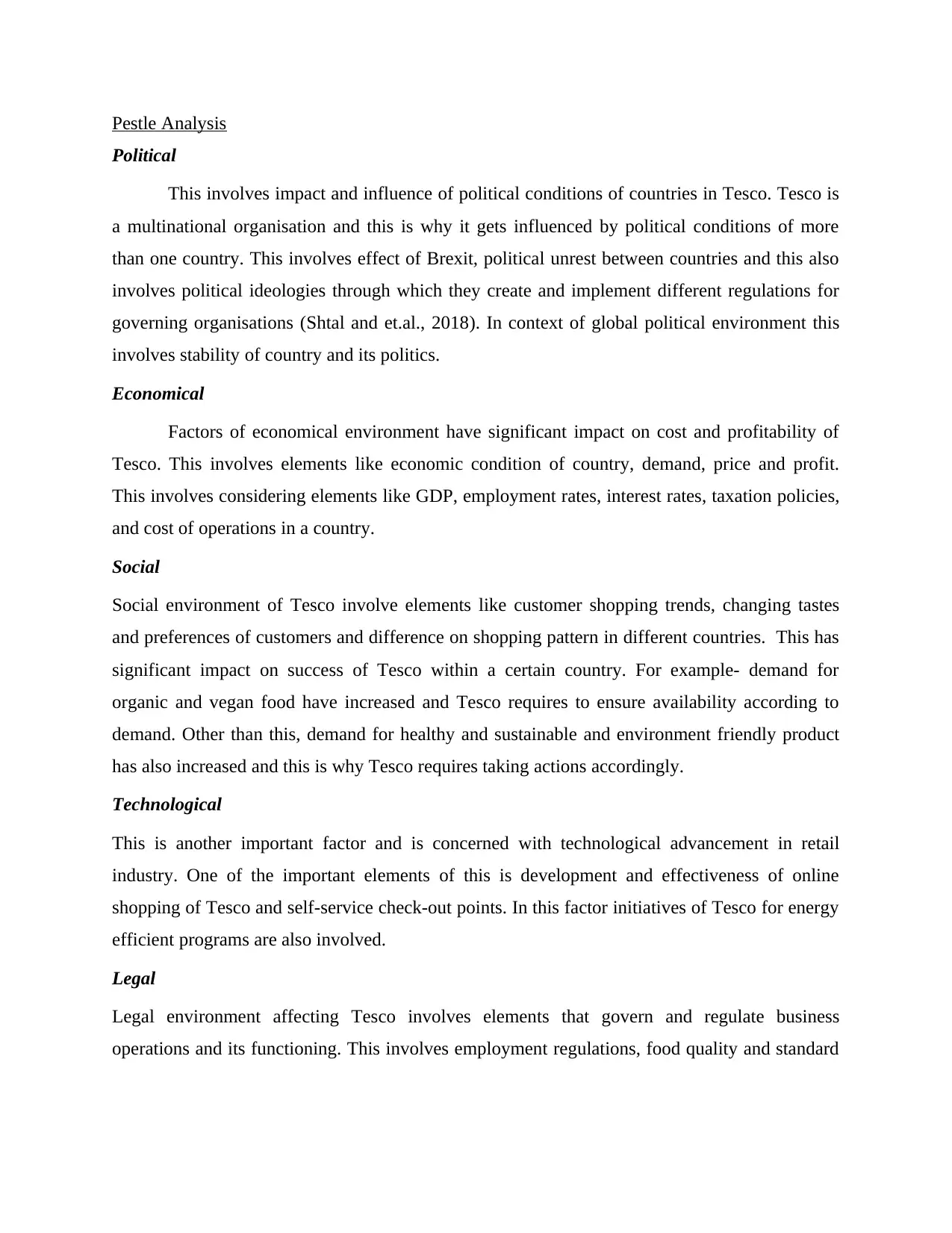
Pestle Analysis
Political
This involves impact and influence of political conditions of countries in Tesco. Tesco is
a multinational organisation and this is why it gets influenced by political conditions of more
than one country. This involves effect of Brexit, political unrest between countries and this also
involves political ideologies through which they create and implement different regulations for
governing organisations (Shtal and et.al., 2018). In context of global political environment this
involves stability of country and its politics.
Economical
Factors of economical environment have significant impact on cost and profitability of
Tesco. This involves elements like economic condition of country, demand, price and profit.
This involves considering elements like GDP, employment rates, interest rates, taxation policies,
and cost of operations in a country.
Social
Social environment of Tesco involve elements like customer shopping trends, changing tastes
and preferences of customers and difference on shopping pattern in different countries. This has
significant impact on success of Tesco within a certain country. For example- demand for
organic and vegan food have increased and Tesco requires to ensure availability according to
demand. Other than this, demand for healthy and sustainable and environment friendly product
has also increased and this is why Tesco requires taking actions accordingly.
Technological
This is another important factor and is concerned with technological advancement in retail
industry. One of the important elements of this is development and effectiveness of online
shopping of Tesco and self-service check-out points. In this factor initiatives of Tesco for energy
efficient programs are also involved.
Legal
Legal environment affecting Tesco involves elements that govern and regulate business
operations and its functioning. This involves employment regulations, food quality and standard
Political
This involves impact and influence of political conditions of countries in Tesco. Tesco is
a multinational organisation and this is why it gets influenced by political conditions of more
than one country. This involves effect of Brexit, political unrest between countries and this also
involves political ideologies through which they create and implement different regulations for
governing organisations (Shtal and et.al., 2018). In context of global political environment this
involves stability of country and its politics.
Economical
Factors of economical environment have significant impact on cost and profitability of
Tesco. This involves elements like economic condition of country, demand, price and profit.
This involves considering elements like GDP, employment rates, interest rates, taxation policies,
and cost of operations in a country.
Social
Social environment of Tesco involve elements like customer shopping trends, changing tastes
and preferences of customers and difference on shopping pattern in different countries. This has
significant impact on success of Tesco within a certain country. For example- demand for
organic and vegan food have increased and Tesco requires to ensure availability according to
demand. Other than this, demand for healthy and sustainable and environment friendly product
has also increased and this is why Tesco requires taking actions accordingly.
Technological
This is another important factor and is concerned with technological advancement in retail
industry. One of the important elements of this is development and effectiveness of online
shopping of Tesco and self-service check-out points. In this factor initiatives of Tesco for energy
efficient programs are also involved.
Legal
Legal environment affecting Tesco involves elements that govern and regulate business
operations and its functioning. This involves employment regulations, food quality and standard
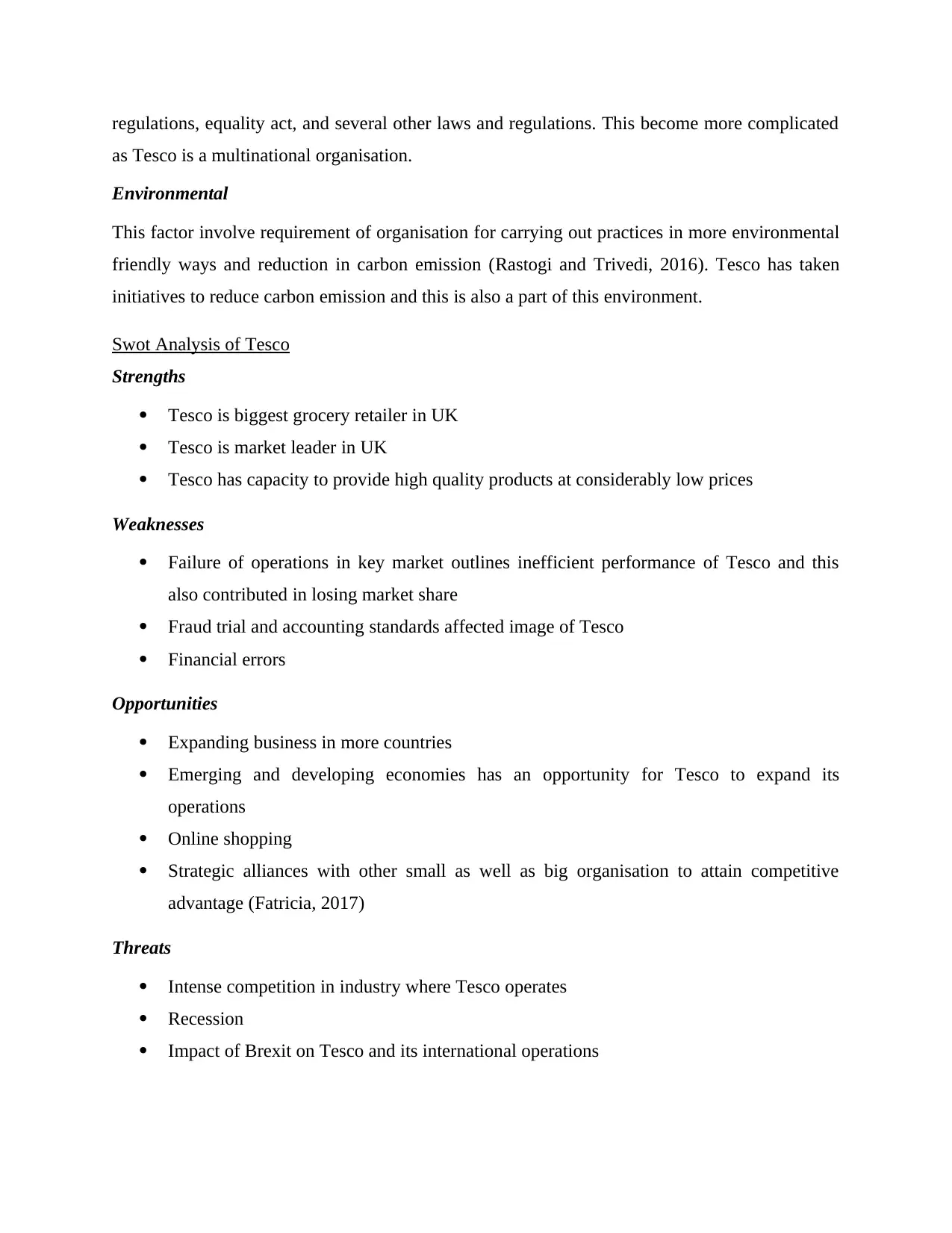
regulations, equality act, and several other laws and regulations. This become more complicated
as Tesco is a multinational organisation.
Environmental
This factor involve requirement of organisation for carrying out practices in more environmental
friendly ways and reduction in carbon emission (Rastogi and Trivedi, 2016). Tesco has taken
initiatives to reduce carbon emission and this is also a part of this environment.
Swot Analysis of Tesco
Strengths
Tesco is biggest grocery retailer in UK
Tesco is market leader in UK
Tesco has capacity to provide high quality products at considerably low prices
Weaknesses
Failure of operations in key market outlines inefficient performance of Tesco and this
also contributed in losing market share
Fraud trial and accounting standards affected image of Tesco
Financial errors
Opportunities
Expanding business in more countries
Emerging and developing economies has an opportunity for Tesco to expand its
operations
Online shopping
Strategic alliances with other small as well as big organisation to attain competitive
advantage (Fatricia, 2017)
Threats
Intense competition in industry where Tesco operates
Recession
Impact of Brexit on Tesco and its international operations
as Tesco is a multinational organisation.
Environmental
This factor involve requirement of organisation for carrying out practices in more environmental
friendly ways and reduction in carbon emission (Rastogi and Trivedi, 2016). Tesco has taken
initiatives to reduce carbon emission and this is also a part of this environment.
Swot Analysis of Tesco
Strengths
Tesco is biggest grocery retailer in UK
Tesco is market leader in UK
Tesco has capacity to provide high quality products at considerably low prices
Weaknesses
Failure of operations in key market outlines inefficient performance of Tesco and this
also contributed in losing market share
Fraud trial and accounting standards affected image of Tesco
Financial errors
Opportunities
Expanding business in more countries
Emerging and developing economies has an opportunity for Tesco to expand its
operations
Online shopping
Strategic alliances with other small as well as big organisation to attain competitive
advantage (Fatricia, 2017)
Threats
Intense competition in industry where Tesco operates
Recession
Impact of Brexit on Tesco and its international operations
⊘ This is a preview!⊘
Do you want full access?
Subscribe today to unlock all pages.

Trusted by 1+ million students worldwide
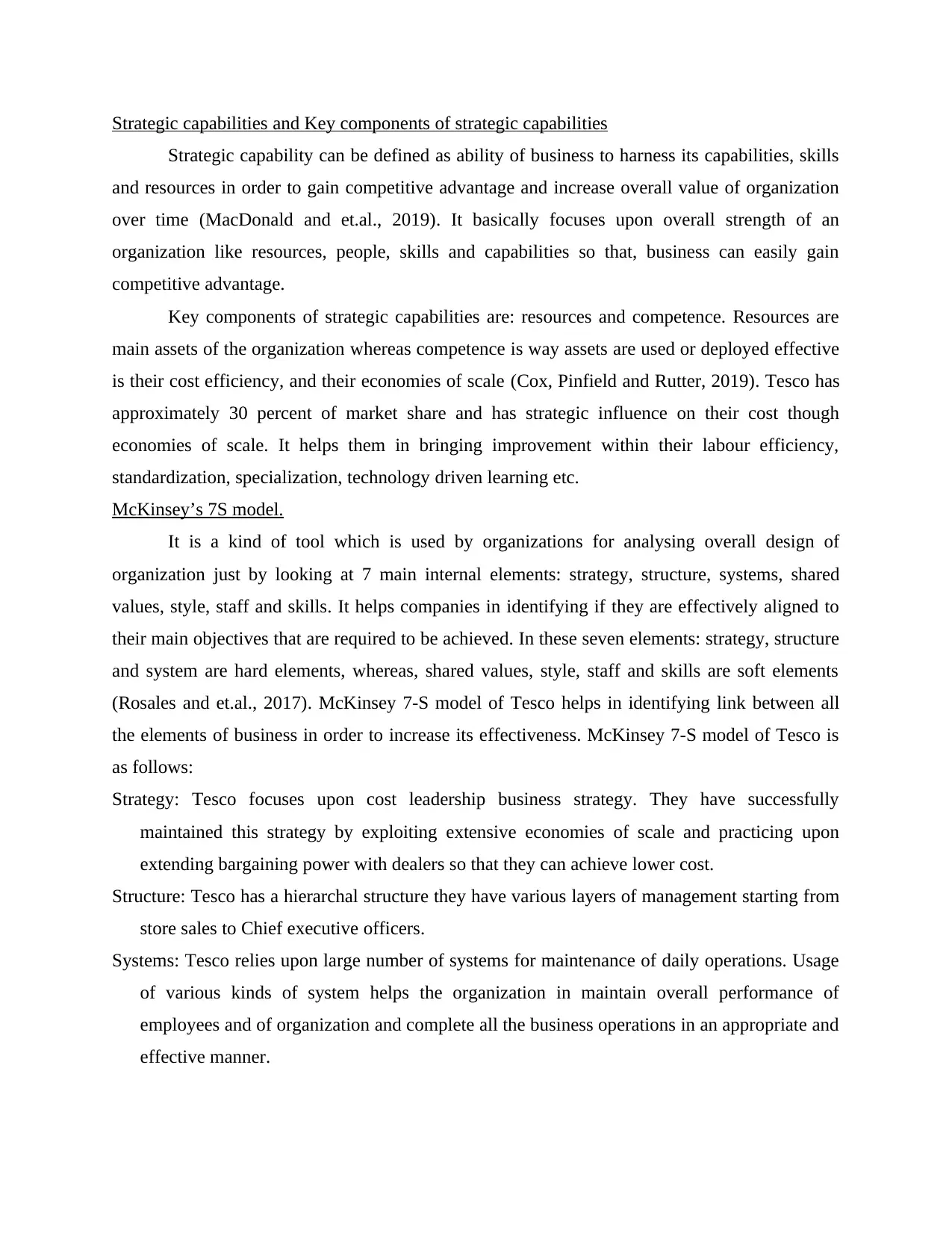
Strategic capabilities and Key components of strategic capabilities
Strategic capability can be defined as ability of business to harness its capabilities, skills
and resources in order to gain competitive advantage and increase overall value of organization
over time (MacDonald and et.al., 2019). It basically focuses upon overall strength of an
organization like resources, people, skills and capabilities so that, business can easily gain
competitive advantage.
Key components of strategic capabilities are: resources and competence. Resources are
main assets of the organization whereas competence is way assets are used or deployed effective
is their cost efficiency, and their economies of scale (Cox, Pinfield and Rutter, 2019). Tesco has
approximately 30 percent of market share and has strategic influence on their cost though
economies of scale. It helps them in bringing improvement within their labour efficiency,
standardization, specialization, technology driven learning etc.
McKinsey’s 7S model.
It is a kind of tool which is used by organizations for analysing overall design of
organization just by looking at 7 main internal elements: strategy, structure, systems, shared
values, style, staff and skills. It helps companies in identifying if they are effectively aligned to
their main objectives that are required to be achieved. In these seven elements: strategy, structure
and system are hard elements, whereas, shared values, style, staff and skills are soft elements
(Rosales and et.al., 2017). McKinsey 7-S model of Tesco helps in identifying link between all
the elements of business in order to increase its effectiveness. McKinsey 7-S model of Tesco is
as follows:
Strategy: Tesco focuses upon cost leadership business strategy. They have successfully
maintained this strategy by exploiting extensive economies of scale and practicing upon
extending bargaining power with dealers so that they can achieve lower cost.
Structure: Tesco has a hierarchal structure they have various layers of management starting from
store sales to Chief executive officers.
Systems: Tesco relies upon large number of systems for maintenance of daily operations. Usage
of various kinds of system helps the organization in maintain overall performance of
employees and of organization and complete all the business operations in an appropriate and
effective manner.
Strategic capability can be defined as ability of business to harness its capabilities, skills
and resources in order to gain competitive advantage and increase overall value of organization
over time (MacDonald and et.al., 2019). It basically focuses upon overall strength of an
organization like resources, people, skills and capabilities so that, business can easily gain
competitive advantage.
Key components of strategic capabilities are: resources and competence. Resources are
main assets of the organization whereas competence is way assets are used or deployed effective
is their cost efficiency, and their economies of scale (Cox, Pinfield and Rutter, 2019). Tesco has
approximately 30 percent of market share and has strategic influence on their cost though
economies of scale. It helps them in bringing improvement within their labour efficiency,
standardization, specialization, technology driven learning etc.
McKinsey’s 7S model.
It is a kind of tool which is used by organizations for analysing overall design of
organization just by looking at 7 main internal elements: strategy, structure, systems, shared
values, style, staff and skills. It helps companies in identifying if they are effectively aligned to
their main objectives that are required to be achieved. In these seven elements: strategy, structure
and system are hard elements, whereas, shared values, style, staff and skills are soft elements
(Rosales and et.al., 2017). McKinsey 7-S model of Tesco helps in identifying link between all
the elements of business in order to increase its effectiveness. McKinsey 7-S model of Tesco is
as follows:
Strategy: Tesco focuses upon cost leadership business strategy. They have successfully
maintained this strategy by exploiting extensive economies of scale and practicing upon
extending bargaining power with dealers so that they can achieve lower cost.
Structure: Tesco has a hierarchal structure they have various layers of management starting from
store sales to Chief executive officers.
Systems: Tesco relies upon large number of systems for maintenance of daily operations. Usage
of various kinds of system helps the organization in maintain overall performance of
employees and of organization and complete all the business operations in an appropriate and
effective manner.
Paraphrase This Document
Need a fresh take? Get an instant paraphrase of this document with our AI Paraphraser
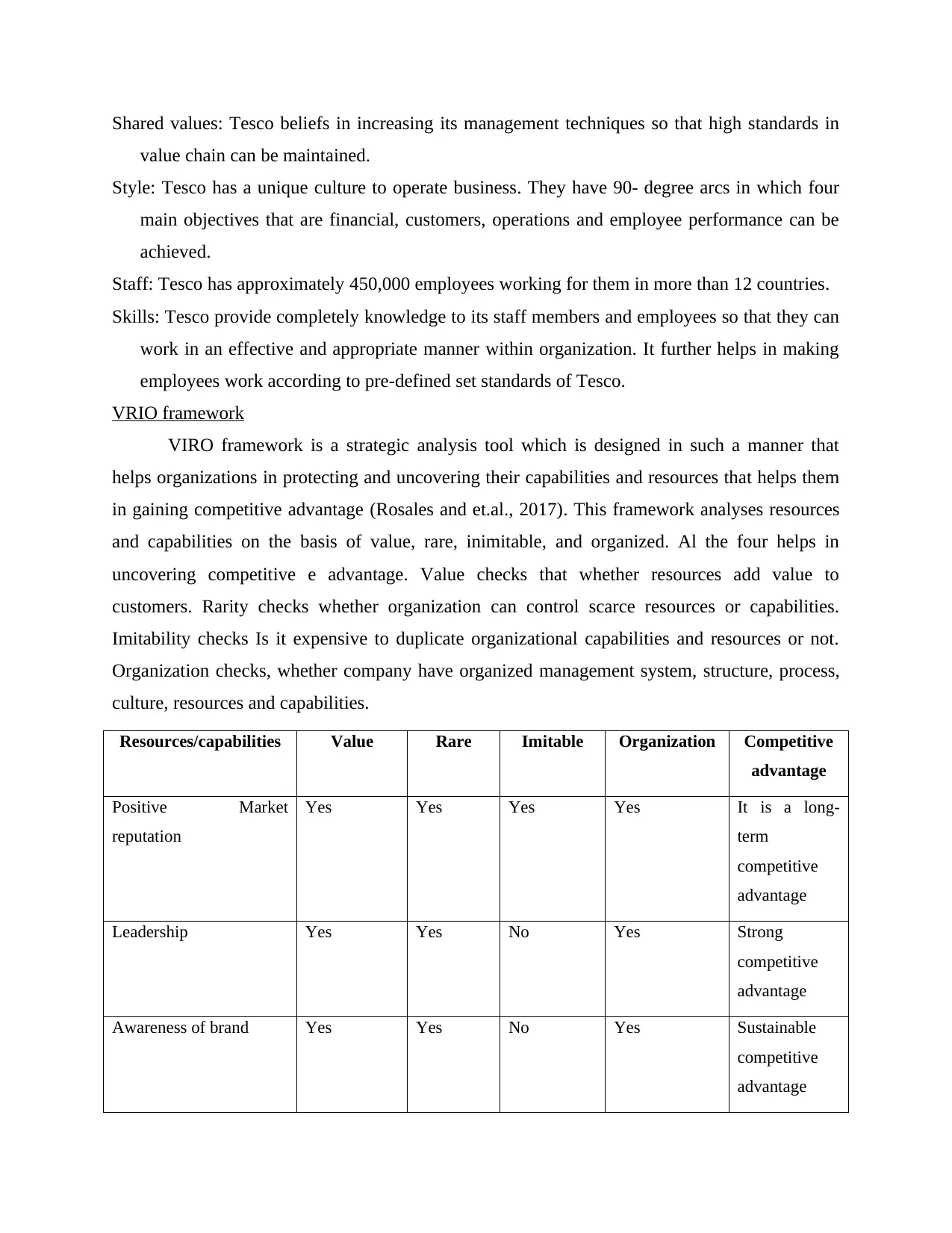
Shared values: Tesco beliefs in increasing its management techniques so that high standards in
value chain can be maintained.
Style: Tesco has a unique culture to operate business. They have 90- degree arcs in which four
main objectives that are financial, customers, operations and employee performance can be
achieved.
Staff: Tesco has approximately 450,000 employees working for them in more than 12 countries.
Skills: Tesco provide completely knowledge to its staff members and employees so that they can
work in an effective and appropriate manner within organization. It further helps in making
employees work according to pre-defined set standards of Tesco.
VRIO framework
VIRO framework is a strategic analysis tool which is designed in such a manner that
helps organizations in protecting and uncovering their capabilities and resources that helps them
in gaining competitive advantage (Rosales and et.al., 2017). This framework analyses resources
and capabilities on the basis of value, rare, inimitable, and organized. Al the four helps in
uncovering competitive e advantage. Value checks that whether resources add value to
customers. Rarity checks whether organization can control scarce resources or capabilities.
Imitability checks Is it expensive to duplicate organizational capabilities and resources or not.
Organization checks, whether company have organized management system, structure, process,
culture, resources and capabilities.
Resources/capabilities Value Rare Imitable Organization Competitive
advantage
Positive Market
reputation
Yes Yes Yes Yes It is a long-
term
competitive
advantage
Leadership Yes Yes No Yes Strong
competitive
advantage
Awareness of brand Yes Yes No Yes Sustainable
competitive
advantage
value chain can be maintained.
Style: Tesco has a unique culture to operate business. They have 90- degree arcs in which four
main objectives that are financial, customers, operations and employee performance can be
achieved.
Staff: Tesco has approximately 450,000 employees working for them in more than 12 countries.
Skills: Tesco provide completely knowledge to its staff members and employees so that they can
work in an effective and appropriate manner within organization. It further helps in making
employees work according to pre-defined set standards of Tesco.
VRIO framework
VIRO framework is a strategic analysis tool which is designed in such a manner that
helps organizations in protecting and uncovering their capabilities and resources that helps them
in gaining competitive advantage (Rosales and et.al., 2017). This framework analyses resources
and capabilities on the basis of value, rare, inimitable, and organized. Al the four helps in
uncovering competitive e advantage. Value checks that whether resources add value to
customers. Rarity checks whether organization can control scarce resources or capabilities.
Imitability checks Is it expensive to duplicate organizational capabilities and resources or not.
Organization checks, whether company have organized management system, structure, process,
culture, resources and capabilities.
Resources/capabilities Value Rare Imitable Organization Competitive
advantage
Positive Market
reputation
Yes Yes Yes Yes It is a long-
term
competitive
advantage
Leadership Yes Yes No Yes Strong
competitive
advantage
Awareness of brand Yes Yes No Yes Sustainable
competitive
advantage
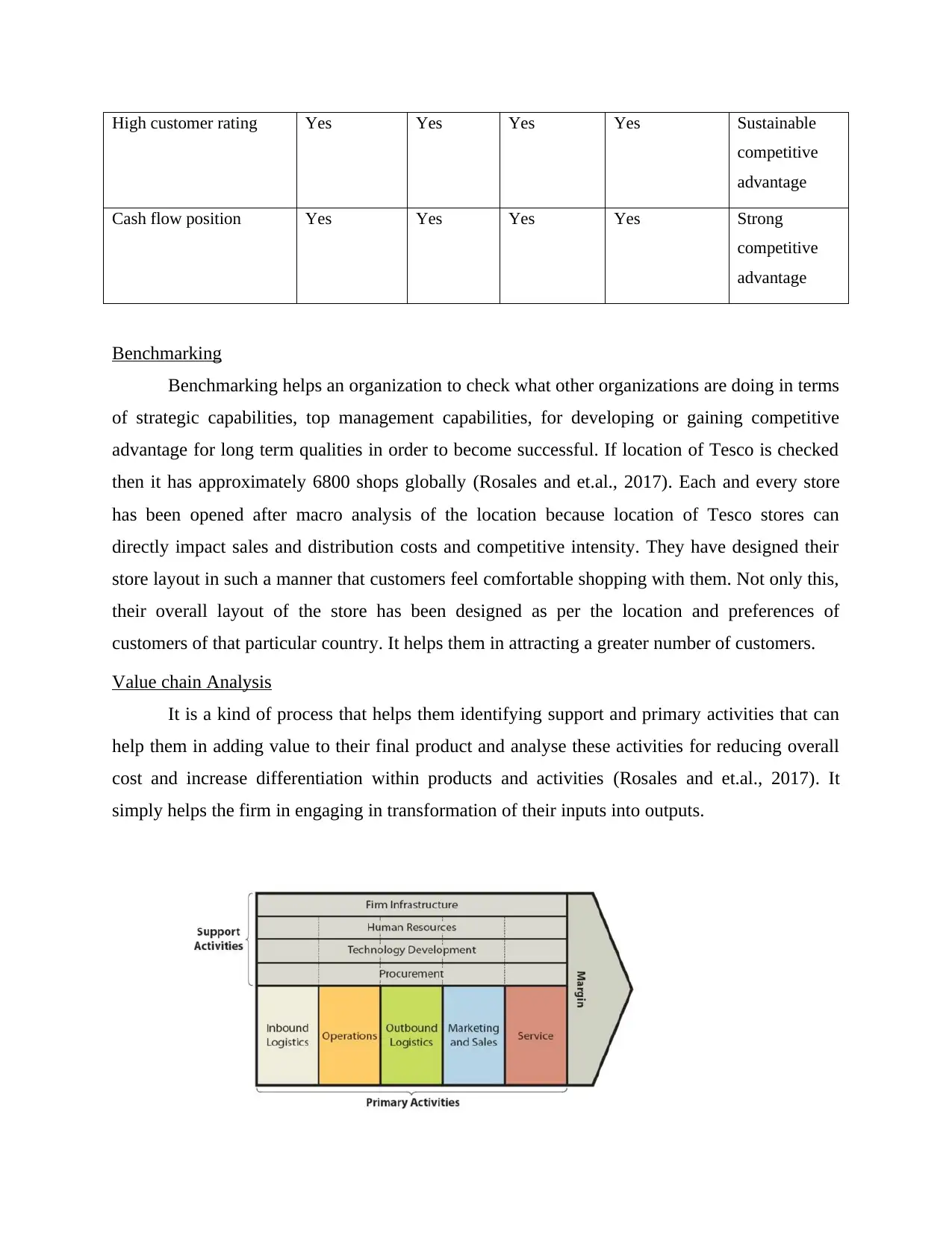
High customer rating Yes Yes Yes Yes Sustainable
competitive
advantage
Cash flow position Yes Yes Yes Yes Strong
competitive
advantage
Benchmarking
Benchmarking helps an organization to check what other organizations are doing in terms
of strategic capabilities, top management capabilities, for developing or gaining competitive
advantage for long term qualities in order to become successful. If location of Tesco is checked
then it has approximately 6800 shops globally (Rosales and et.al., 2017). Each and every store
has been opened after macro analysis of the location because location of Tesco stores can
directly impact sales and distribution costs and competitive intensity. They have designed their
store layout in such a manner that customers feel comfortable shopping with them. Not only this,
their overall layout of the store has been designed as per the location and preferences of
customers of that particular country. It helps them in attracting a greater number of customers.
Value chain Analysis
It is a kind of process that helps them identifying support and primary activities that can
help them in adding value to their final product and analyse these activities for reducing overall
cost and increase differentiation within products and activities (Rosales and et.al., 2017). It
simply helps the firm in engaging in transformation of their inputs into outputs.
competitive
advantage
Cash flow position Yes Yes Yes Yes Strong
competitive
advantage
Benchmarking
Benchmarking helps an organization to check what other organizations are doing in terms
of strategic capabilities, top management capabilities, for developing or gaining competitive
advantage for long term qualities in order to become successful. If location of Tesco is checked
then it has approximately 6800 shops globally (Rosales and et.al., 2017). Each and every store
has been opened after macro analysis of the location because location of Tesco stores can
directly impact sales and distribution costs and competitive intensity. They have designed their
store layout in such a manner that customers feel comfortable shopping with them. Not only this,
their overall layout of the store has been designed as per the location and preferences of
customers of that particular country. It helps them in attracting a greater number of customers.
Value chain Analysis
It is a kind of process that helps them identifying support and primary activities that can
help them in adding value to their final product and analyse these activities for reducing overall
cost and increase differentiation within products and activities (Rosales and et.al., 2017). It
simply helps the firm in engaging in transformation of their inputs into outputs.
⊘ This is a preview!⊘
Do you want full access?
Subscribe today to unlock all pages.

Trusted by 1+ million students worldwide
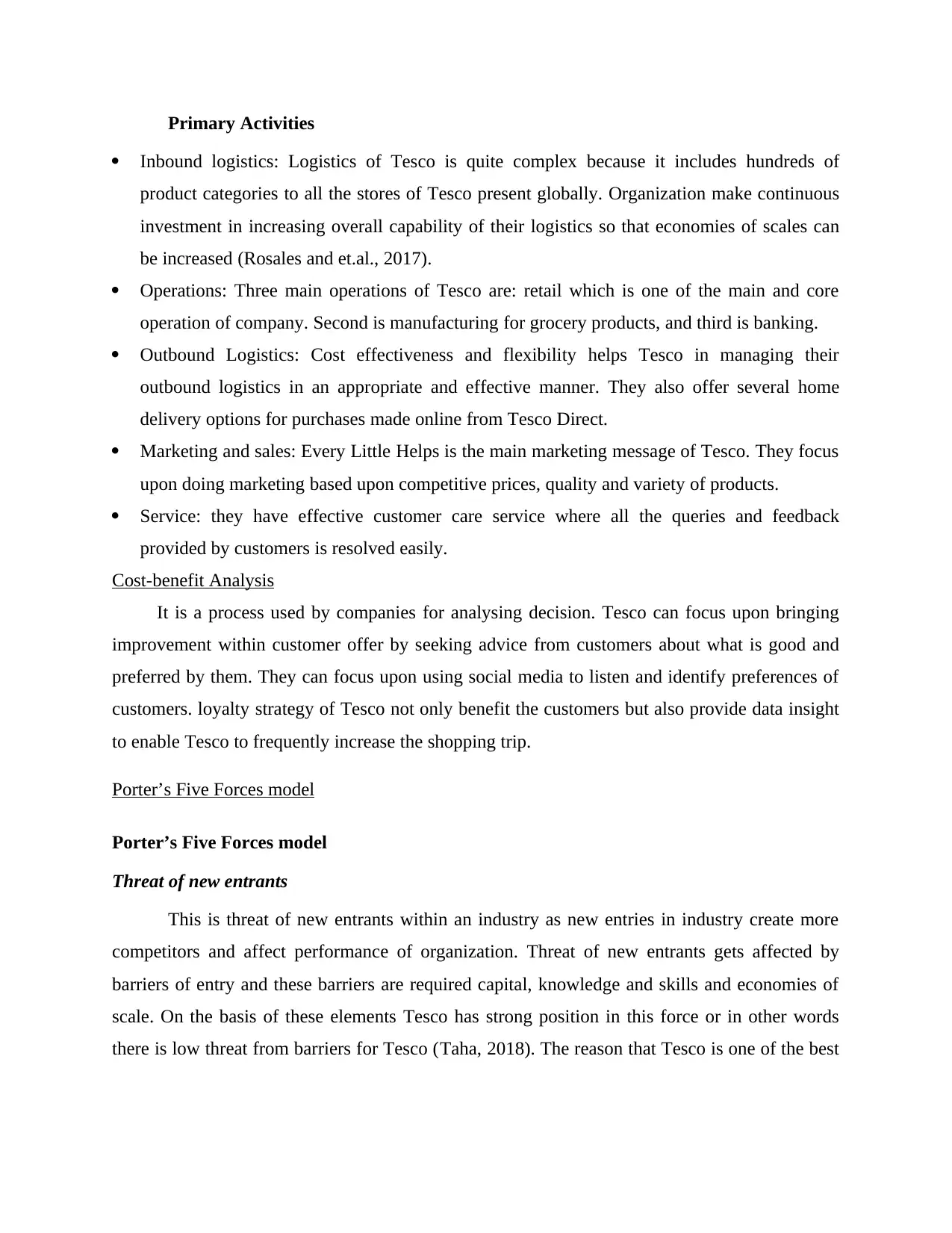
Primary Activities
Inbound logistics: Logistics of Tesco is quite complex because it includes hundreds of
product categories to all the stores of Tesco present globally. Organization make continuous
investment in increasing overall capability of their logistics so that economies of scales can
be increased (Rosales and et.al., 2017).
Operations: Three main operations of Tesco are: retail which is one of the main and core
operation of company. Second is manufacturing for grocery products, and third is banking.
Outbound Logistics: Cost effectiveness and flexibility helps Tesco in managing their
outbound logistics in an appropriate and effective manner. They also offer several home
delivery options for purchases made online from Tesco Direct.
Marketing and sales: Every Little Helps is the main marketing message of Tesco. They focus
upon doing marketing based upon competitive prices, quality and variety of products.
Service: they have effective customer care service where all the queries and feedback
provided by customers is resolved easily.
Cost-benefit Analysis
It is a process used by companies for analysing decision. Tesco can focus upon bringing
improvement within customer offer by seeking advice from customers about what is good and
preferred by them. They can focus upon using social media to listen and identify preferences of
customers. loyalty strategy of Tesco not only benefit the customers but also provide data insight
to enable Tesco to frequently increase the shopping trip.
Porter’s Five Forces model
Porter’s Five Forces model
Threat of new entrants
This is threat of new entrants within an industry as new entries in industry create more
competitors and affect performance of organization. Threat of new entrants gets affected by
barriers of entry and these barriers are required capital, knowledge and skills and economies of
scale. On the basis of these elements Tesco has strong position in this force or in other words
there is low threat from barriers for Tesco (Taha, 2018). The reason that Tesco is one of the best
Inbound logistics: Logistics of Tesco is quite complex because it includes hundreds of
product categories to all the stores of Tesco present globally. Organization make continuous
investment in increasing overall capability of their logistics so that economies of scales can
be increased (Rosales and et.al., 2017).
Operations: Three main operations of Tesco are: retail which is one of the main and core
operation of company. Second is manufacturing for grocery products, and third is banking.
Outbound Logistics: Cost effectiveness and flexibility helps Tesco in managing their
outbound logistics in an appropriate and effective manner. They also offer several home
delivery options for purchases made online from Tesco Direct.
Marketing and sales: Every Little Helps is the main marketing message of Tesco. They focus
upon doing marketing based upon competitive prices, quality and variety of products.
Service: they have effective customer care service where all the queries and feedback
provided by customers is resolved easily.
Cost-benefit Analysis
It is a process used by companies for analysing decision. Tesco can focus upon bringing
improvement within customer offer by seeking advice from customers about what is good and
preferred by them. They can focus upon using social media to listen and identify preferences of
customers. loyalty strategy of Tesco not only benefit the customers but also provide data insight
to enable Tesco to frequently increase the shopping trip.
Porter’s Five Forces model
Porter’s Five Forces model
Threat of new entrants
This is threat of new entrants within an industry as new entries in industry create more
competitors and affect performance of organization. Threat of new entrants gets affected by
barriers of entry and these barriers are required capital, knowledge and skills and economies of
scale. On the basis of these elements Tesco has strong position in this force or in other words
there is low threat from barriers for Tesco (Taha, 2018). The reason that Tesco is one of the best
Paraphrase This Document
Need a fresh take? Get an instant paraphrase of this document with our AI Paraphraser
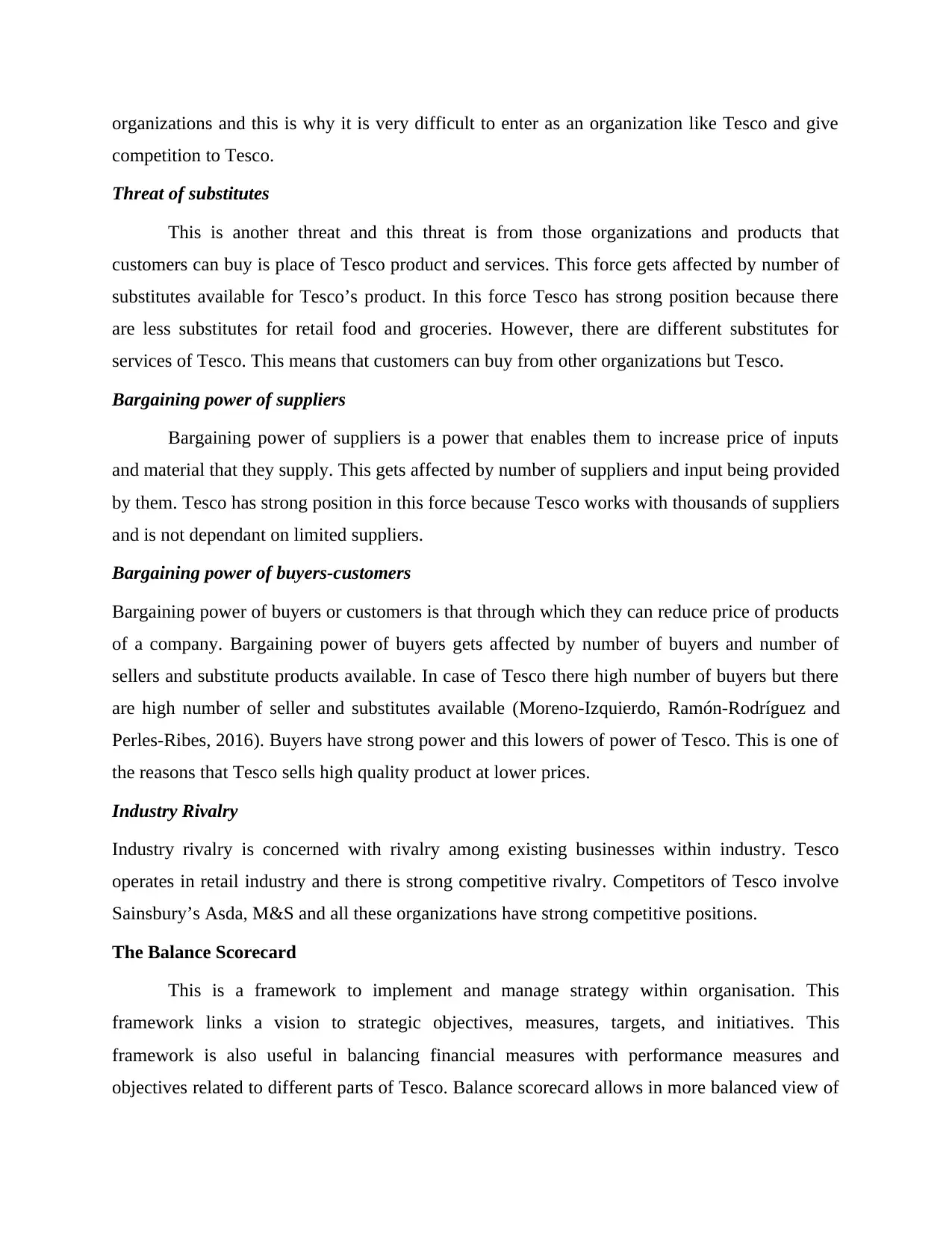
organizations and this is why it is very difficult to enter as an organization like Tesco and give
competition to Tesco.
Threat of substitutes
This is another threat and this threat is from those organizations and products that
customers can buy is place of Tesco product and services. This force gets affected by number of
substitutes available for Tesco’s product. In this force Tesco has strong position because there
are less substitutes for retail food and groceries. However, there are different substitutes for
services of Tesco. This means that customers can buy from other organizations but Tesco.
Bargaining power of suppliers
Bargaining power of suppliers is a power that enables them to increase price of inputs
and material that they supply. This gets affected by number of suppliers and input being provided
by them. Tesco has strong position in this force because Tesco works with thousands of suppliers
and is not dependant on limited suppliers.
Bargaining power of buyers-customers
Bargaining power of buyers or customers is that through which they can reduce price of products
of a company. Bargaining power of buyers gets affected by number of buyers and number of
sellers and substitute products available. In case of Tesco there high number of buyers but there
are high number of seller and substitutes available (Moreno-Izquierdo, Ramón-Rodríguez and
Perles-Ribes, 2016). Buyers have strong power and this lowers of power of Tesco. This is one of
the reasons that Tesco sells high quality product at lower prices.
Industry Rivalry
Industry rivalry is concerned with rivalry among existing businesses within industry. Tesco
operates in retail industry and there is strong competitive rivalry. Competitors of Tesco involve
Sainsbury’s Asda, M&S and all these organizations have strong competitive positions.
The Balance Scorecard
This is a framework to implement and manage strategy within organisation. This
framework links a vision to strategic objectives, measures, targets, and initiatives. This
framework is also useful in balancing financial measures with performance measures and
objectives related to different parts of Tesco. Balance scorecard allows in more balanced view of
competition to Tesco.
Threat of substitutes
This is another threat and this threat is from those organizations and products that
customers can buy is place of Tesco product and services. This force gets affected by number of
substitutes available for Tesco’s product. In this force Tesco has strong position because there
are less substitutes for retail food and groceries. However, there are different substitutes for
services of Tesco. This means that customers can buy from other organizations but Tesco.
Bargaining power of suppliers
Bargaining power of suppliers is a power that enables them to increase price of inputs
and material that they supply. This gets affected by number of suppliers and input being provided
by them. Tesco has strong position in this force because Tesco works with thousands of suppliers
and is not dependant on limited suppliers.
Bargaining power of buyers-customers
Bargaining power of buyers or customers is that through which they can reduce price of products
of a company. Bargaining power of buyers gets affected by number of buyers and number of
sellers and substitute products available. In case of Tesco there high number of buyers but there
are high number of seller and substitutes available (Moreno-Izquierdo, Ramón-Rodríguez and
Perles-Ribes, 2016). Buyers have strong power and this lowers of power of Tesco. This is one of
the reasons that Tesco sells high quality product at lower prices.
Industry Rivalry
Industry rivalry is concerned with rivalry among existing businesses within industry. Tesco
operates in retail industry and there is strong competitive rivalry. Competitors of Tesco involve
Sainsbury’s Asda, M&S and all these organizations have strong competitive positions.
The Balance Scorecard
This is a framework to implement and manage strategy within organisation. This
framework links a vision to strategic objectives, measures, targets, and initiatives. This
framework is also useful in balancing financial measures with performance measures and
objectives related to different parts of Tesco. Balance scorecard allows in more balanced view of
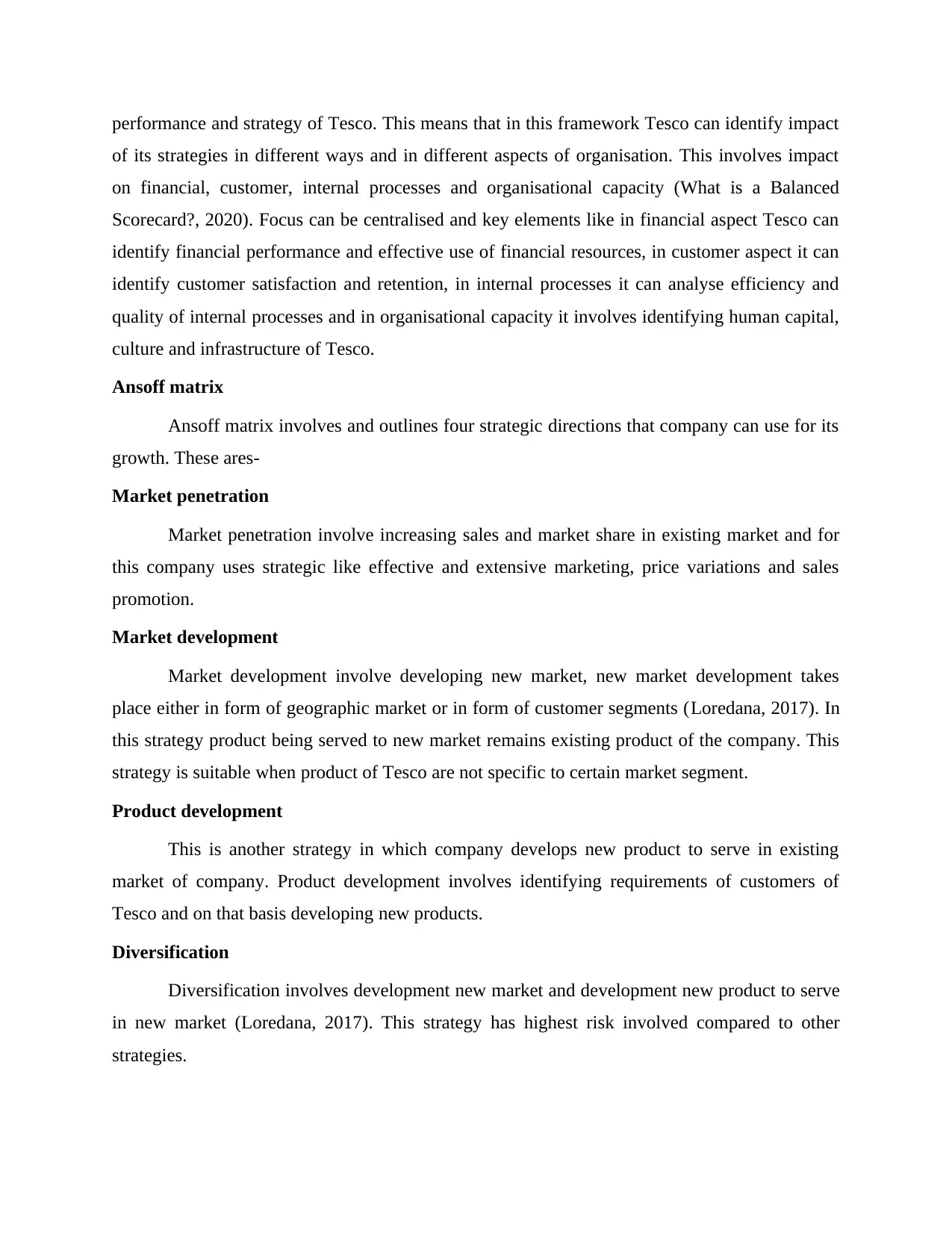
performance and strategy of Tesco. This means that in this framework Tesco can identify impact
of its strategies in different ways and in different aspects of organisation. This involves impact
on financial, customer, internal processes and organisational capacity (What is a Balanced
Scorecard?, 2020). Focus can be centralised and key elements like in financial aspect Tesco can
identify financial performance and effective use of financial resources, in customer aspect it can
identify customer satisfaction and retention, in internal processes it can analyse efficiency and
quality of internal processes and in organisational capacity it involves identifying human capital,
culture and infrastructure of Tesco.
Ansoff matrix
Ansoff matrix involves and outlines four strategic directions that company can use for its
growth. These ares-
Market penetration
Market penetration involve increasing sales and market share in existing market and for
this company uses strategic like effective and extensive marketing, price variations and sales
promotion.
Market development
Market development involve developing new market, new market development takes
place either in form of geographic market or in form of customer segments (Loredana, 2017). In
this strategy product being served to new market remains existing product of the company. This
strategy is suitable when product of Tesco are not specific to certain market segment.
Product development
This is another strategy in which company develops new product to serve in existing
market of company. Product development involves identifying requirements of customers of
Tesco and on that basis developing new products.
Diversification
Diversification involves development new market and development new product to serve
in new market (Loredana, 2017). This strategy has highest risk involved compared to other
strategies.
of its strategies in different ways and in different aspects of organisation. This involves impact
on financial, customer, internal processes and organisational capacity (What is a Balanced
Scorecard?, 2020). Focus can be centralised and key elements like in financial aspect Tesco can
identify financial performance and effective use of financial resources, in customer aspect it can
identify customer satisfaction and retention, in internal processes it can analyse efficiency and
quality of internal processes and in organisational capacity it involves identifying human capital,
culture and infrastructure of Tesco.
Ansoff matrix
Ansoff matrix involves and outlines four strategic directions that company can use for its
growth. These ares-
Market penetration
Market penetration involve increasing sales and market share in existing market and for
this company uses strategic like effective and extensive marketing, price variations and sales
promotion.
Market development
Market development involve developing new market, new market development takes
place either in form of geographic market or in form of customer segments (Loredana, 2017). In
this strategy product being served to new market remains existing product of the company. This
strategy is suitable when product of Tesco are not specific to certain market segment.
Product development
This is another strategy in which company develops new product to serve in existing
market of company. Product development involves identifying requirements of customers of
Tesco and on that basis developing new products.
Diversification
Diversification involves development new market and development new product to serve
in new market (Loredana, 2017). This strategy has highest risk involved compared to other
strategies.
⊘ This is a preview!⊘
Do you want full access?
Subscribe today to unlock all pages.

Trusted by 1+ million students worldwide
1 out of 17
Related Documents
Your All-in-One AI-Powered Toolkit for Academic Success.
+13062052269
info@desklib.com
Available 24*7 on WhatsApp / Email
![[object Object]](/_next/static/media/star-bottom.7253800d.svg)
Unlock your academic potential
Copyright © 2020–2025 A2Z Services. All Rights Reserved. Developed and managed by ZUCOL.





